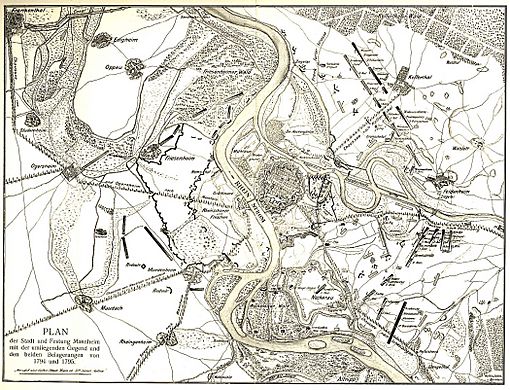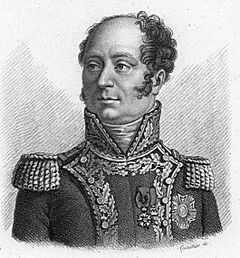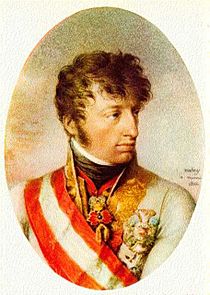Battle of Mannheim (1799) facts for kids
Quick facts for kids Battle of Mannheim (1799) |
|||||||
|---|---|---|---|---|---|---|---|
| Part of War of the Second Coalition | |||||||
|
|||||||
| Belligerents | |||||||
| Commanders and leaders | |||||||
| Strength | |||||||
| 18,000–22,000 | 5,200 | ||||||
| Casualties and losses | |||||||
| 1,300 | 3,500, 23 guns, 2 colors | ||||||
The Battle of Mannheim happened on September 18, 1799. It was a fight between the Austrian army, led by Archduke Charles, Duke of Teschen, and the French army, led by Jacques Léonard Muller. This battle was part of the larger War of the Second Coalition.
Most of the French Army of the Rhine had moved to the west side of the Rhine River. However, a part of the French army, led by Antoine Laroche Dubouscat, stayed behind to defend Mannheim. Mannheim is a city in southwest Germany.
Even with help from Michel Ney, Laroche's soldiers were defeated. Archduke Charles attacked them with a much larger force. The French were pushed out of Mannheim, giving the Austrians a victory.
In the summer of 1799, the French Army of the Rhine had about 18,000 soldiers. Their main job was to make Archduke Charles's Austrian army move away from Switzerland. At that time, another French army, led by André Masséna, was fighting in Switzerland.
The French army under Muller moved south from Mannheim and started to attack Philippsburg. This made Archduke Charles worried about his supply lines. So, Charles and his 30,000 soldiers moved north to face Muller. Muller quickly pulled his army back.
Leaving Laroche's soldiers in Mannheim was a mistake for Muller. But overall, his plan worked. Masséna was able to strongly defeat a Russian army in Switzerland at the Second Battle of Zurich on September 25 and 26.
Why the Battle Happened
The War of the Second Coalition Begins
The War of the Second Coalition was a big conflict in Europe. It involved several countries fighting against France. One of the early battles was the First Battle of Zurich on June 4, 1799. In this battle, the French army fought against the Austrian army.
The French army was led by André Masséna. The Austrian army was led by Archduke Charles, Duke of Teschen. After this battle, the French moved to a strong defensive spot near Zürich.
Forming the Army of the Rhine
The Army of the Rhine was created on July 5, 1799. Its job was to protect a long area along the Rhine River. This area stretched from Neuf-Brisach in the south to Düsseldorf in the north. It included important forts like Strasbourg and Mannheim.
The French said this army had 40,000 to 60,000 soldiers. But this was a trick to fool the Austrians. In reality, many soldiers were busy guarding forts. Only about 18,000 soldiers were available for fighting in the field.
The main goal of the Army of the Rhine was to draw the Austrian army away from Masséna's forces in Switzerland. They hoped to threaten Archduke Charles's supply routes. The army was not strong enough for a big battle, but it was a big enough threat to get the Austrians' attention.
Changes in Allied Plans
Meanwhile, a combined army of Austrians and Russians had been very successful in Italy. They had pushed the French out of most of Italy.
Around this time, the Allied countries decided on a new plan. The idea was for a Russian army to march into Switzerland. They would join other Russian and Austrian soldiers there. This large force would then invade France.
At the same time, Archduke Charles was supposed to move his 60,000 Austrian soldiers north into southern Germany. From there, he would also invade France. The leaders of Russia and the Holy Roman Empire approved this plan.
However, Archduke Charles was not sure about the plan. He thought splitting up the armies was a bad idea. In the end, the timing was off. Charles left Switzerland too early, and the Russian army arrived too late. This caused problems for the Allies.
The Campaign and Battle
French Army Moves Out
By the end of August 1799, the French Army of the Rhine was ready. It had three main groups of infantry soldiers and a group of cavalry (soldiers on horseback).
On August 26, Muller's army, with about 18,000 soldiers, began to move. Different parts of the army marched in different directions. Michel Ney was a new general in the army. He was given a special advance group of soldiers.
Ney's soldiers moved ahead and captured towns like Heilbronn. The French army also began to attack the fortress of Philippsburg. They threatened to burn the town if it did not surrender. But the governor of Philippsburg refused to give up.
Archduke Charles Responds
Archduke Charles did not want to move too far from Masséna's army in Switzerland. But when Philippsburg was attacked, he started to move his army north.
By September 5, the French knew that Charles was getting closer. Even though the attack on Philippsburg had only just begun, the French had already caused damage. Still, Muller decided to stop the attack and pull his army back towards Mannheim.
By September 13, most of the French Army of the Rhine was safely on the west side of the Rhine River.
The Battle for Mannheim
In a big mistake, Muller left Laroche's group of soldiers in Mannheim. Mannheim was on the east side of the Rhine. Laroche knew his soldiers were in a dangerous spot. He asked Ney for advice. Ney suggested moving the bridge to a different location.
On September 18, Archduke Charles attacked Laroche's soldiers. Charles had about 22,000 soldiers. Laroche only had 5,200. Even though they were greatly outnumbered, the French fought bravely.
Ney brought some of his soldiers to help. But the Austrians took control of an area called Neckerau, on Laroche's right side. They then pushed towards the bridge. The Austrians almost crossed the bridge to the west side of the river. But the French managed to stop them just in time.
Results of the Battle
In the Battle of Mannheim, the French lost many soldiers. About 1,600 were killed or wounded. The Austrians captured 1,900 French soldiers, 23 cannons, and two flags. The Austrians lost about 1,300 soldiers.
General Ney was injured during the battle. Laroche's group of soldiers was almost completely destroyed. After the battle, there was a lot of blame. Some French generals were unhappy with Muller for retreating. Ney and Laroche felt they had been left in a difficult situation.
However, Muller's decision to retreat was probably smart. His 18,000 soldiers were much fewer than Charles's 30,000. Fighting a big battle would have been very risky. Muller actually succeeded in his main mission. He drew Archduke Charles away from Switzerland.
Impact on the War
While the Battle of Mannheim was happening, important events were unfolding in Switzerland. On September 25, Masséna's French army defeated a large Russian army at the Second Battle of Zurich. The French won a big victory there.
On the same day, another French force surprised and defeated an Austrian army. The Austrian general, Friedrich Freiherr von Hotze, was killed. These victories were very important for the French.
A Russian army, led by Alexander Suvorov, had entered Switzerland from the south. After dealing with the other Allied armies, Masséna turned to face Suvorov. Suvorov's army had a very difficult march through the Alps. They eventually escaped the French, but with many losses.
Because of the problems at Mannheim, the French government decided to change commanders. Claude Lecourbe was chosen to lead the Army of the Rhine. However, Lecourbe was busy fighting Suvorov. So, Michel Ney reluctantly took temporary command of the army.





